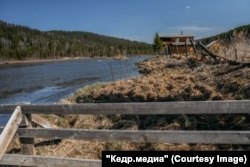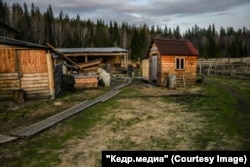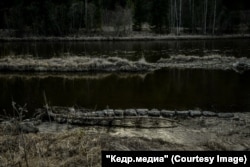KOLBINSKY, Russia -- From Krasnoyarsk to the village of Kolbinsky is roughly 167 kilometers, about 100 of which are on asphalt and then gravel. On the asphalt road, there is a lot of traffic, but as you turn onto the gravel road, you enter a pine forest and quickly arrive at the Seyba River.
The river is broad, sometimes turbulent and occasionally tranquil. At the bends, there is hardly a discernible current. The one thing that stands out is the murkiness of the river's water. I cautiously descend the hill with a clean, 3-liter jar in order to carefully gather up its water without stirring up the sediment underneath.
In Kolbinsky, I cross a bridge over the Kuvay River. I take a second jar and fill it with water. The water from the Kuvay is clear. The water from the Seyba looks like diluted milk with a thick layer of sediment at the bottom of the jar. Even though there are officially no gold miners upstream, this is one of the indications that they are there. The situation was the exact opposite a few months prior: the Sebya was clear, while the Kuvay's water was murky.
A fifth of Russia's gold reserves are mined in the Krasnoyarsk region -- about 70 tons per year. Gold mining is typically done by large companies, though there are also small teams of panhandlers. The large gold-mining companies often use powerful equipment to lift the silt from the bottom of rivers. They also dig up kilometers of forest along the riverbanks. This callous disregard for nature is not only causing damage to the environment but also tragedies.
In 2014, villagers from Partizanskoye, in the Motyginsky district, formed a human wall to block an access road to their village. The villagers were driven to despair by the mining companies that were practically digging in their backyards. Their water was poisoned, their gardens, which they depended upon for their subsistence, were dredged, and the constant blasting caused cracks in their homes.
Though the village is surrounded by gold, its people live in poverty.
The gold mining company Vasilyevsky Rudnik was blasting a quarry some 500 meters from the village. It was also next to the cemetery. Business people and municipal authorities were forced to work out a compromise, and a decision was made: All of the villagers would be relocated.
In 2019, villagers from Tayaty, in the Karatuz district, filed a complaint with the regional government about gold miners from the Yenisei Gold Company. Their once-pristine river had been spoiled. The villagers gathered on the banks of the Kazyr River with a huge banner above their heads with the inscription: "We are the gold of the Tayaty region." The photo was sent to the regional government before their plight went viral on the Internet.
The regional Environment Ministry carried out an inspection. Their results showed that the permissible concentrations of copper and gold were exceeded by a magnitude of 18 times on the Nizhniye Tayaty River, almost four times on the Kazyr River, and 21 times on the Verkhniye Tayaty River.
With the Dremuchka and Mozharka rivers also showing high concentrations that exceeded permissible levels, the mining company was fined.
In October 2019, the largest gold-mining disaster in the Kuraginsky region occurred when water from a broken dam allowed the Seyba River to spill out, causing flooding that claimed the lives of 17 people and injured 27 others.
With The Best Of Intentions
A proposed law allowing private entrepreneurs to mine gold was given a reading in the State Duma in July. Currently, only legal entities are permitted to mine. The government backed the proposal, citing a desire to generate new employment opportunities for its citizens.
While Russia is making it easier, the laws governing gold mining in neighboring nations are only tightening. Mongolia has restricted alluvial gold mining to just 30 percent of the country's land area, citing its wish to protect vital natural regions for its people.
In China, they banned alluvial gold mining altogether, recognizing that it is impossible to control the miners, who often leave behind serious environmental damage.
The Flood
In the village of Kolbinsky, there is no cell-phone service; it remains only a dream for its residents. The village has a rich history. It arose in 1909 from a hunting lodge. Then, following the Stolypin reforms (which allowed peasants to increase their land holdings, eliminated communal villages, and offered people affordable lines of credit for private land ownership), people began to come here.
In those years, the village was called Skotoprogonni. According to legend, there was a trail along which cattle were driven from Mongolia to Russia. In 1976, the village was renamed Kolbinskoye, after the name of the river flowing nearby. The wild garlic found here in the spring is considered a Siberian delicacy.
On the night of June 7, 2020, the Kuvay River began to overflow its banks. Of the 500 residents in the village, more than 120 were forced to evacuate. The resulting flood inundated the village homes, wiping away gardens and outbuildings. With 30 homes under water, the authorities were forced to house the villagers in a council building. Everyone who could left to stay with relatives.
Olga Yeremenko, a saleswoman at a local store, recalls: "Everything was floating. Vegetable gardens were destroyed. Low-lying buildings were flooded, and we barely managed to save our cattle. We’ve had rains before, as well as floods, but this was something we have never experienced."
On the second day, as the water began to recede, the victims were given 10,000 rubles ($103) each, but this did not compensate for their losses from the flood.
According to the official account, flooding was to blame for what happened to the village. The residents have a different opinion, putting the blame on the gold miners, who the villagers say broke open the dams upstream to allow excess water from settling tanks to overflow.
The Fish Are Almost Gone
In September 2021, contaminated water arrived in the villages of Kolbinsky and Bolshoy Ungut. The river was now a strangely yellow stream that carried a great deal of clay. There were clogs in every pump that people used to collect water for their cattle and themselves.
With a worried population, local authorities began to write letters to the district, region, and prosecutor's office. Aleksandr Litvinov, director of the small Kabarozhka tourist center, which is located 10 kilometers from Kolbinsky, in the village of Novovasilyevka, became involved.
"When the gold miners began dumping waste into the river...there were almost no fish. You could say my business collapsed. Previously, we caught grayling and taimen. Nowadays, they are rare, as river fish need clean water. When pollution occurs, silt, suspended matter, and clay settle on the bottom, and the fish leave. Even if you stock the river with fish, it will be of little use. There is no food," Litvinov says.
When the visibly polluted waters began to spread, Litvinov contacted the environmental prosecutor's office, but nothing changed. Officials were unable or uninterested in finding out who was at fault.
Artem Chernykh, the district chief for the Mansky area, was the lone official who made an effort to assist. He was responsible for several gold miners receiving fines and others losing their permits. The river became cleaner for a while, but since gold mining was allowed to continue on the Kuvay, the issue of poor water quality reappeared.
The Kuvay River is still polluted. The water treatment facilities used by the mining operators periodically break, allowing poisoned water and effluent to travel down to the villagers. A new regional governor is being named, but it is still unclear what to expect from the new administration.
"I think there is a conflict between businesses and the people who live in these places. We don't need this gold. We just want to live here," Litvinov said.
He is not the only one worried about the condition of the river. There are others who monitor the quality of the water and often send pictures showing the contamination to the prosecutor's office. However, most residents remain inactive and appear unconcerned about the impending loss of the river.
Prosecutors have vowed to launch inquiries if they receive complaints. However, locals are unsure if any inquiries have actually taken place over the last few years.
The problem is that they can't catch the offenders in the act. Typically, the pollution has already been washed away by the time inspectors arrive. According to Litvinov, these issues would lessen if federal officials implemented the right tracking mechanisms to monitor the situation. But these devices are expensive, and the villagers cannot expect any financial help on the local level.
Not Only Gold
Maria Timofeyevna Timoshenko is over 70 years old. She has spent her professional life at the school in Kolbinsky, rising through the ranks from a teacher of Russian language and literature to the position of school director. She has fought for clean rivers and has been a well-known social activist for many years.
Timoshenko says that villagers never sought work in the gold mines -- neither now or under the Soviet Union. The better jobs were provided by the logging enterprises, and the mines would resort to bringing in outsiders.
"Most of our men worked as lumberjacks and earned good money. The forest was never cut along the banks. It was always at least 100 meters away, no closer, as this would lead to the collapse of the earth, allowing the bottom to silt up and causing the river to become shallower," she says.
"All the residents knew this, so we protected the river from private logging. Today, no one is fighting because they don't know those who have received a license and are doing the work. The head of the village doesn’t even know. It’s the same with gold miners. They just enter the territory and start working," Timoshenko says.
After the closure of the timber enterprise in the 1990s, small private companies began to harvest timber, followed by Chinese companies. The local residents have no idea how the loggers obtained licenses. They only see the damage done after they have left.
In the vicinity of Kolbinsky, everything has been cut down. Due to the lack of forest, there are no animals left to hunt. The river is also devoid of life. Previously, grayling, a type of freshwater salmon, were easily caught as a main source of food. Now, the grayling are gone.
People Were Torn From Their Homes
The head of the village, Natalya Lakomova, says the big problem is that she, as a government representative, has virtually no authority. She cannot enforce regulations for gold-mining companies, despite the fact that they are located on the territory entrusted to her.
"Just recently, they came to the village council. They didn’t introduce themselves and didn’t show any documents. They just said that they were coming for geological exploration, asking for help with accommodation and finding cooks for them. I refused. Why should we help them? I immediately notified the district. Their response is that nobody knows anything either," Lakomova says.
"People are also worried that they will receive the same treatment as the villagers in Zhayma. When the miners discovered gold, all of the residents were voluntarily and forcibly relocated to a village where they were given two-room apartments. In Zhayma, everyone had their own plot of land for farming and growing vegetables. This was the main source of food for the locals," she says. "People were simply torn from their homes and taken away."
Russia Is Losing More And More Rivers
The former head of the Mansky district, Artem Chernykh, continues to monitor the situation and maintain contact with local residents.
"The activities of gold-mining companies are subject to federal supervision," said Chernykh. "But the feds don’t have enough specialists, so we worked closely with everyone. We notified each other, coordinated our actions, and went to mining sites together so that the company would not be subjected to a nightmare of many inspections.
"We also ensured that they were not unsupervised, and this had its desired effect. The people and the environment do not suffer," he adds.
Aleksandr Kolotov, an ecologist, claims that gold mining turns rivers into sewage systems. He believes a moratorium on the extraction of precious metals in areas where they are not yet mined and where the rivers are unpolluted could help solve the problem of the Siberian rivers.
Environmental organizations have submitted such proposals to the Russian government. But they were told that revenue from gold mining is too important for the state budget and that there will be no suspension of the issuance of licenses.
In the span of three days -- from June 5-7 -- experts in the Krasnoyarsk region identified 15 cases of water pollution. Environmentalists sent complaints to the head of the Yenisei interregional department of Rosprirodnadzor, a governmental environmental watchdog, with a request to carry out an inspection: "We believe that the pollution is a direct result of the mining of gold.... Our findings indicate significant damage to the environment of the Krasnoyarsk territory has occurred."
Months later, there is still no answer.
Monitoring captures only one small part of the situation, as it does not cover the areas of intensive gold mining in the northern regions.
"We simply don’t have the resources for this," Kolotov laments. "There are images from satellites, though they do not capture the spillways opening up at night."
However, even from the photographs that are available, a shocking picture of devastation is coming into focus as more Siberian rivers are being lost due to the mining industry.
Russian courts also do not recognize satellite photos as proof. To successfully take on the mining industry, specialists must travel to the sites, take water samples, do an analysis, and only after the results show contamination that exceeds normal parameters can a fine be issued. Many rivers are located in hard-to-reach areas, a fact that unscrupulous miners take advantage of.
In addition, the gold miners must be informed about the inspector’s arrival -- that is, the wolf must be warned that the hunter is coming.
Epilogue
On August 2, Kolotov sent me pictures of pollution in the Mana, a river into which the Kolba, Seyba, and Kuvay flow. At the same time, he sent the pictures to the Yenisei interregional department of Rosprirodnadzor.
There is still no response from the regulatory authorities.






